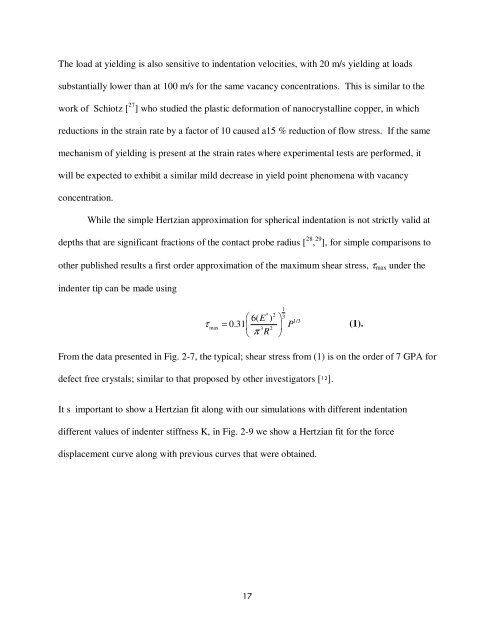DEFECTS IN METALS AND SIMULATION OF MECHANICAL ...
DEFECTS IN METALS AND SIMULATION OF MECHANICAL ...
DEFECTS IN METALS AND SIMULATION OF MECHANICAL ...
Create successful ePaper yourself
Turn your PDF publications into a flip-book with our unique Google optimized e-Paper software.
The load at yielding is also sensitive to indentation velocities, with 20 m/s yielding at loads<br />
substantially lower than at 100 m/s for the same vacancy concentrations. This is similar to the<br />
work of Schiotz [ 27 ] who studied the plastic deformation of nanocrystalline copper, in which<br />
reductions in the strain rate by a factor of 10 caused a15 % reduction of flow stress. If the same<br />
mechanism of yielding is present at the strain rates where experimental tests are performed, it<br />
will be expected to exhibit a similar mild decrease in yield point phenomena with vacancy<br />
concentration.<br />
While the simple Hertzian approximation for spherical indentation is not strictly valid at<br />
depths that are significant fractions of the contact probe radius [ 28 , 29 ], for simple comparisons to<br />
other published results a first order approximation of the maximum shear stress, τ max under the<br />
indenter tip can be made using<br />
τ<br />
max 3 2<br />
1<br />
* 2 3<br />
⎛ 6( E ) ⎞<br />
= 0.31⎜ ⎟<br />
⎝ π R ⎠<br />
P<br />
1/3<br />
(1).<br />
From the data presented in Fig. 2-7, the typical; shear stress from (1) is on the order of 7 GPA for<br />
defect free crystals; similar to that proposed by other investigators [ 12 ].<br />
It s important to show a Hertzian fit along with our simulations with different indentation<br />
different values of indenter stiffness K, in Fig. 2-9 we show a Hertzian fit for the force<br />
displacement curve along with previous curves that were obtained.<br />
17

















